
Centaurea is a genus of over 700 species of herbaceous thistle-like flowering plants in the family Asteraceae. Members of the genus are found only north of the equator, mostly in the Eastern Hemisphere; the Middle East and surrounding regions are particularly species-rich.
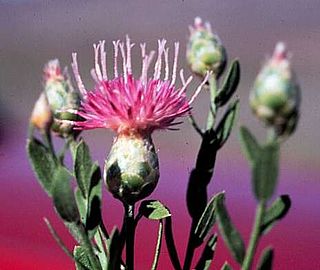
Rhaponticum repens, synonyms including Acroptilon repens and Leuzea repens, with the common name Russian knapweed, is a species of bushy rhizomatous perennial, up to 80 cm tall. Stems and leaves are finely arachnoid-tomentose becoming glabrous and green with age. The rosette leaves are oblanceolate, pinnately lobed to entire, 2–3 cm wide by 3–8 cm long. The lower cauline leaves are smaller, pinnately lobed; the upper leaves become much reduced, sessile, serrate to entire. The heads are numerous terminating the branches. Flowers are pink to purplish, the marginal ones not enlarged. The outer and middle involucral bracts are broad, striate, smooth with broadly rounded tips; the inner bracts are narrower with hairy tips. Pappus present with bristles 6–11 mm long. Fruit is a whitish, slightly ridged achene.
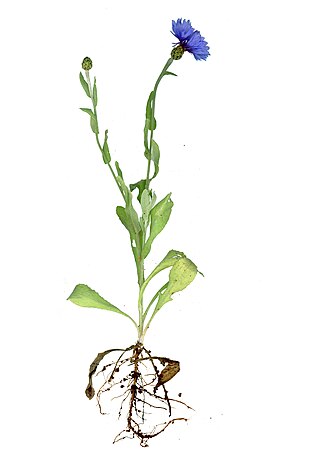
Centaurea cyanus, commonly known as cornflower or bachelor's button, is an annual flowering plant in the family Asteraceae native to Europe. In the past, it often grew as a weed in cornfields, hence its name. It is now endangered in its native habitat by agricultural intensification, particularly by over-use of herbicides. However, Centaurea cyanus is now also naturalised in many other parts of the world, including North America and parts of Australia through introduction as an ornamental plant in gardens and as a seed contaminant in crop seeds.

Centaurea diffusa, also known as diffuse knapweed, white knapweed or tumble knapweed, is a member of the genus Centaurea in the family Asteraceae. This species is common throughout western North America but is not actually native to the North American continent, but to the eastern Mediterranean.

Centaurea solstitialis, the yellow star-thistle, is a species of thorny plant in the genus Centaurea, which is part of the family Asteraceae. A winter annual, it is native to the Mediterranean Basin region and invasive in many other places. It is also known as golden starthistle, yellow cockspur and St. Barnaby's thistle.

Safranal is an organic compound isolated from saffron, the spice consisting of the stigmas of crocus flowers. It is the constituent primarily responsible for the aroma of saffron.

Centaurea montana, the perennial cornflower, mountain cornflower, bachelor's button, montane knapweed or mountain bluet, is a species of flowering plant in the family Asteraceae, endemic to Europe. It is widespread and common in the more southerly mountain ranges of Europe, but is rarer in the north. It escapes from gardens readily, and has thereby become established in the British Isles, Scandinavia and North America. This plant has become an invasive species in British Columbia, Canada. Centaurea montana grows in meadows and open woodland in the upper montane and sub-alpine zones, in basic areas. It grows to 30–70 centimetres (12–28 in) tall, and flowers mainly from May to August.

Centaurea cineraria, the velvet centaurea, also known as dusty miller and silver dust, is a species of flowering plant in the family Asteraceae endemic to southern Italy. In natural settings, it grows on coastal cliffs, ranging from 0–350 m above sea level, hence the plant's Italian name, fiordaliso delle scogliere. Mature plants may reach 80 centimetres (31.5 in) in height. The species produces purple flowers.

Centaurea jacea, brown knapweed or brownray knapweed, is a species of herbaceous perennial plants in the genus Centaurea native to dry meadows and open woodland throughout Europe. It grows to 10–80 centimetres (4–31 in) tall, and flowers mainly from June to September. It has simple leaves that are alternate in arrangement.

Agonopterix arenella is a species of moth of the family Depressariidae. It is found in all of Europe, except the Iberian Peninsula.

The Blue Oak Ranch Reserve, a unit of the University of California Natural Reserve System, is an ecological reserve and biological field station in Santa Clara County, California. It is located on 3,260 acres (13.2 km2) in the Diablo Range, northwest of Mount Hamilton, at 1,500 ft (460 m) elevation.

The Grigna is a mountain massif in the province of Lecco, Lombardy, northern Italy, with an elevation of 2,410 metres (7,907 ft). It is part of the Bergamo Alps, and it has two peaks, Grignone or Grigna settentrionale(2,410m), the higher Northern, and the lower, Southern Grignetta or Grigna meridionale (2,184 m).
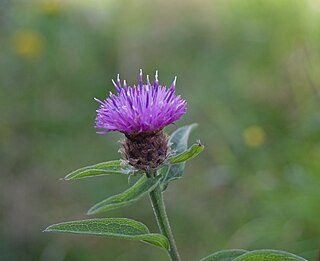
Centaurea nigra is a species of flowering plant in the family Asteraceae known by the common names lesser knapweed, common knapweed and black knapweed. A local vernacular name is hardheads.
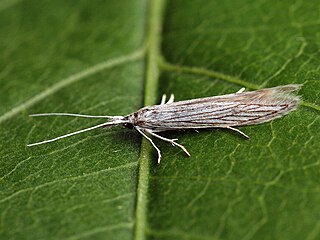
Coleophora brevipalpella is a moth of the family Coleophoridae. It is found from Fennoscandia to the Pyrenees, the Alps and the Carpathian Mountains and from Germany to Romania and North Macedonia.

Agonopterix pallorella is a moth of the family Depressariidae. It is found in most of Europe.

Agonopterix subpropinquella is a moth of the family Depressariidae. It is found in most of Europe.

Agonopterix kaekeritziana is a moth of the family Depressariidae. It is found in most of Europe east to the Near East and the eastern part of the Palearctic realm.

Metzneria metzneriella is a moth of the family Gelechiidae. It is widely distributed throughout Europe, as well as Turkey and southern Siberia. The habitat consists of dry pastures and calcareous soils.
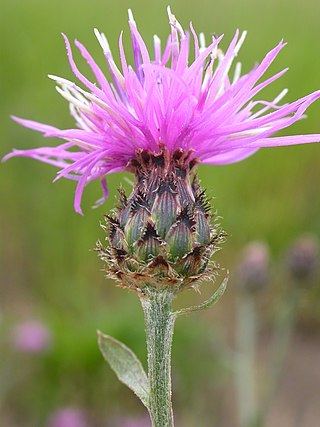
Centaurea stoebe, the spotted knapweed or panicled knapweed, is a species of Centaurea native to eastern Europe, although it has spread to North America, where it is considered an invasive species. It forms a tumbleweed, helping to increase the species' reach, and the seeds are also enabled by a feathery pappus.
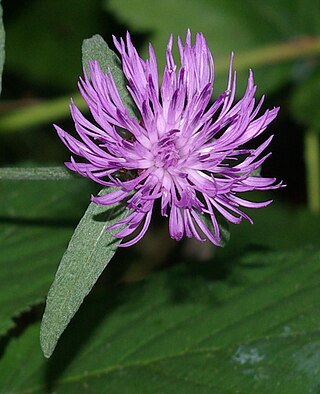
Meadow knapweed, also known as hybrid knapweed or protean knapweed, is a fertile hybrid between black knapweed and brown knapweed. The taxonomic status of the species is uncertain, and meadow knapweed has been variously described as different species.



















